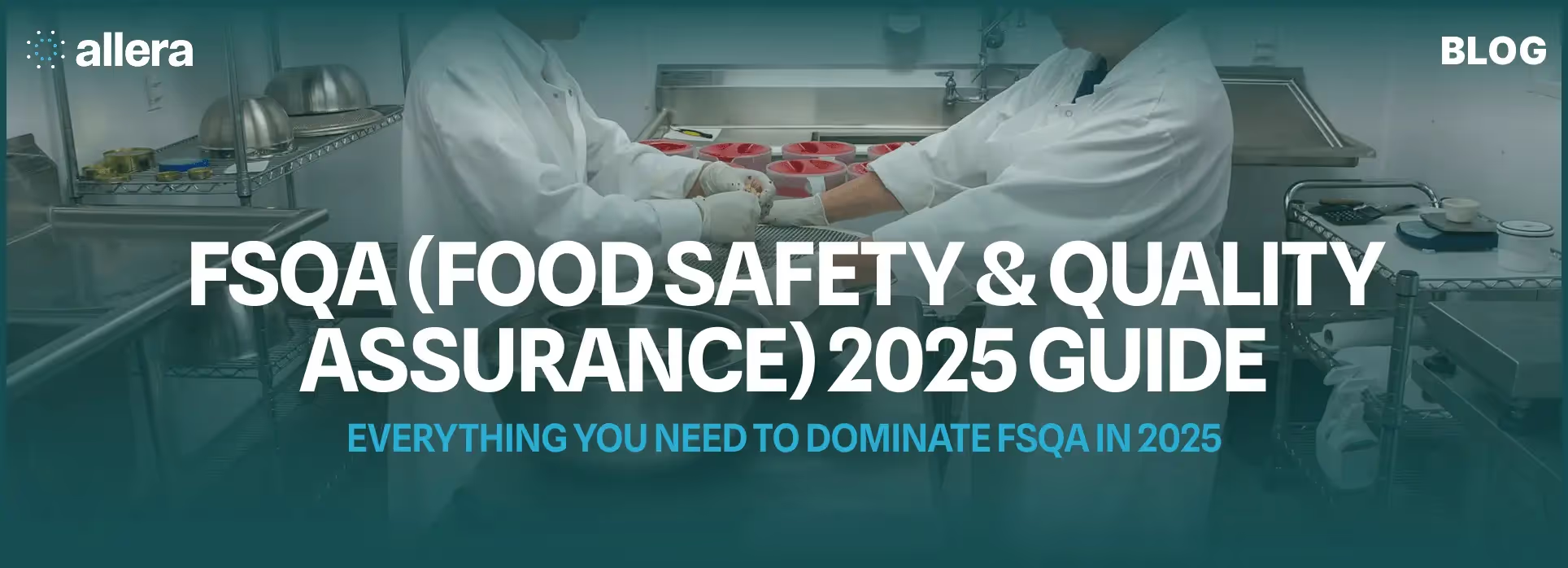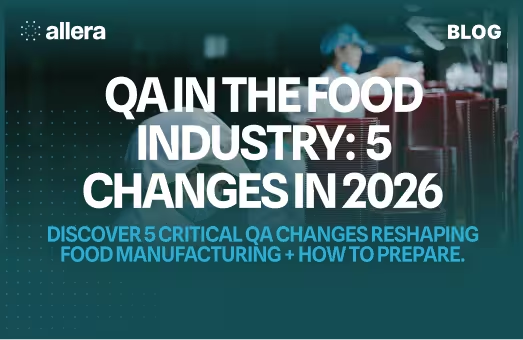

FSQA (Food Safety & Quality Assurance) 2025 Guide

Food Safety and Quality Assurance (FSQA) is your strategy to ensure every product arriving in a consumer's kitchen is free from hazards and meets strict quality standards. It starts with robust policies and procedures and includes ongoing testing, continuous improvement, and accountability across the supply chain.
In this guide, we’ll dive deep into the most essential components of food safety and quality assurance. (Checkout our guide on quality assurance vs quality control!)
By the end, you’ll have a comprehensive understanding of what FSQA looks like in 2025.
FSQA: More Than Simple Compliance
You might think FSQA is only a about meeting government regulations. In truth, it's about maintaining trust. By implementing FSQA programs effectively, you reduce the likelihood of recalls, prevent hazards, and safeguard your brand image. This comprehensive approach involves:
- Hazard analysis (finding potential risks like pathogens or allergens)
- Critical control points (identifying where in the process you must prevent or catch these dangers)
- Ongoing monitoring and verification (through tools, audits, and well-trained staff)
Linking FSQA to Public Health
Strong FSQA practices help protect people from foodborne illnesses. This is especially crucial because consumers rely on you for safe meals. Regulatory bodies such as the FDA and USDA in the United States and the EFSA in Europe set standards for food producers worldwide (FDA). Compliance ensures your products meet basic safety benchmarks, but effective FSQA often goes further by tackling issues before they reach store shelves.
3 Critical Food Safety Hazards: Biological, Chemical & Physical Risks
You can build confidence in your processes by recognizing the main hazards that threaten product safety. Hazard Analysis and Critical Control Points (HACCP) forms the backbone of modern risk management. When your FSQA team knows these risks intimately, you can stop problems before they escalate.
Biological, Chemical, and Physical Hazards
A solid FSQA plan considers 4hazard categories:
- Biological hazards: Pathogens like Salmonella, E. coli, or Listeria can enter your system through raw materials, contaminated surfaces, or improper handling.
- Chemical hazards: Cleaning agents, pesticides, or allergens may accidentally enter the food supply. Monitoring ingredient sources and storing chemicals properly helps to reduce this threat.
- Physical hazards: Pieces of glass, plastic, or metal can find their way into final products if equipment is faulty or staff training is inconsistent.
- Allergenic hazards: Undeclared allergens such as peanuts, milk, soy, or gluten are one of the leading causes of food recalls. Proper labeling, ingredient verification, and cross-contact prevention are critical to protecting sensitive consumers.
The Cost of Oversight
When hazards slip through your FSQA processes, the financial damage can be extensive—recalls, legal consequences, lost consumer trust. According to some estimates (USDA Economic Research Service), countries lose billions of dollars each year to foodborne illnesses and product recalls. Identifying and containing a hazard at an early stage is far cheaper than addressing a full-blown crisis later.
HACCP Implementation Guide: 7 Steps to Prevent Food Safety Issues
HACCP (Hazard Analysis and Critical Control Points) is a cornerstone of FSQA. This system pinpoints possible issues at each stage of food production, putting dedicated checks in place to stop hazards from passing to the next step. When you adopt HACCP, you follow a systematic approach:
- Identify hazards.
- Determine critical control points (CCPs).
- Set critical limits (like temperature thresholds).
- Monitor CCPs regularly.
- Take corrective actions when limits are exceeded.
- Validate the system through continuous documentation.
Why HACCP Matters
Under the Food Safety Modernization Act (FSMA), stringent guidelines require food establishments to emphasize hazard prevention over crisis management. Facilities that integrate HACCP thoroughly see real gains in efficiency, audit performance, and risk mitigation.
According to the FDA, HACCP Principles, implementing HACCP can significantly reduce labor costs while improving audit scores. Good news—this isn't just about meeting legal obligations, it's about continuously improving your day-to-day operations.
Reducing Human Error
Human mistakes occur, especially in busy production lines. Tools like digital checklists paired with wireless sensors can automate many HACCP tasks, freeing your staff to focus on the processes that need a personal touch. The FDA's New Era of Smarter Food Safety initiative emphasizes how advanced cloud platforms allow authorized personnel to access real-time data from anywhere. System alerts highlight when temperature deviates from preset thresholds, making it easier to step in promptly and fix problems before consumers are affected.
FSQA Technology & Software: What 2025 Brings to The Table
As production volumes grow, technology becomes indispensable for maintaining FSQA consistency. You may already rely on automation for packaging or distribution. By expanding tech solutions into daily safety checks, sensor monitoring, and automated alerts, you streamline compliance and reduce risk.
Types of FSQA Technologies
Digital tools in FSQA include wireless sensors that monitor real-time temperature and humidity to catch deviations instantly, digital checklists that replace paper-based tasks to minimize errors and speed up audits, cloud-based dashboards that centralize data for big-picture analytics, and automated alerts that trigger notifications for out-of-limit readings to accelerate corrective actions.
Many modern systems focus on sensor-based monitoring plus integrated dashboards. By connecting data points throughout your facility, you'll uncover patterns in cooling, heating, or storage that might go unnoticed if you relied on manual reports only.
Why Tech Adoption Is Growing
FSQA depends on capturing accurate, up-to-the-minute information. Older systems forced teams to rely on paper logs and manual temperature checks. Today, cloud-based and mobile software solutions let you gather data and analyze trends (IFT Food Technology). There's also a push from regulators toward digital record-keeping since it provides clear proof of compliance. Whether you're aiming to pass a BRC audit or maintain FSMA certification, automated record-keeping can help you meet all the documentation requirements without drowning in paperwork.
FDA, FSMA & Global Food Safety Regulations
Governments worldwide maintain strict standards to protect public health. You'll see recurring frameworks like Codex Alimentarius or ISO 22000, which offer baseline guidance on acceptable hazard levels, labeling requirements, and more (ISO 22000). Specific local rules like the FDA's FSMA in the United States or Europe's EFSA guidance ensure every food item meets safety benchmarks.
Meeting Global Standards
Following recognized standards helps you reach international markets. For example, SQF (Safe Quality Food) certification is accepted worldwide, and so is ISO 22000. Top manufacturers also adhere to GFSI (Global Food Safety Initiative) benchmarks. Leading companies ensure all plants are SQF Certified and staff hold HACCP and FSMA-PCQI certifications for both Human and Animal Food. These credentials showcase a commitment to safety that buyers tend to trust.
Internal Protocols and Documentation
Showing compliance to regulators often comes down to good documentation. Comprehensive recording of temperature logs, cleaning schedules, and hazard evaluations demonstrates whether you're following FSQA protocols. Revisit your internal documentation occasionally, and consider how digital applications might streamline it. A food quality management system can centralize all these details, ensuring you have them ready when a food inspector conducts a surprise check.
FSQA Staffing & Training: Building Your Food Safety Team in 2025
All the technology and perfect procedures in the world can't deliver top-flight FSQA without a well-trained team. Staffing remains a challenge though—retirements, high turnover, and a shortage of specialized skills create gaps in food manufacturing facilities (FDA Workforce Development). Nurturing your current team and attracting new talent are crucial for consistent daily output.
Training and Retention
Food safety professionals need a thorough understanding of production steps, hazard points, and operational technology. Training programs, whether online or in-person, keep staff updated about new regulations, like changes to FSMA rules or the latest sensor-driven solutions. Encourage employees to pursue specialized certifications such as HACCP or PCQI (Preventive Controls Qualified Individual) through the Food Safety Preventive Controls Alliance. You may also want to partner with local colleges or universities to develop a talent pipeline that addresses the specialized tasks of modern FSQA.
Outsourcing Vs. In-House
When labor shortages strike, outsourcing certain FSQA responsibilities is tempting. External experts can swiftly fill knowledge gaps, but they also require orientation to your specific processes. If your facility is in a rural area, you might struggle to attract experienced staff for every shift, so partial outsourcing may help maintain coverage. Keep an eye on consistency and worker engagement, though. A balanced approach ensures you keep core FSQA knowledge in-house while leveraging external expertise when necessary (USDA Rural Development).
Food Safety Audit Preparation: Third-Party & Internal Audit Guide
Audits—whether by government agencies, third-party certifiers, or your own internal teams—are often the linchpin that confirms whether your FSQA program holds up under scrutiny. External audits from well-known programs like SQF or BRC add another layer of credibility, proving that your processes meet global best practices.
Third-Party Audits and Their Benefits
External audits serve as unbiased evaluations. They confirm your food traceability efforts, check for robust hazard controls, and spot potential weak points. Third-party reviews see what your internal team might miss when you're busy meeting daily production targets. They can also help you align with important certification protocols, boosting your brand reputation and making you more appealing to large retailers.
Preparing for Audits
Proper prep prevents surprises. A few steps to keep in mind:
- Collect documentation. Keep your HACCP plan, employee training logs, food safety testing records, and supplier verifications ready.
- Validate your equipment. Make sure temperatures, humidity, and other conditions meet your set limits.
- Test your recall procedure. Quick product recalls save valuable time (and reduce risk) if a hazard does slip through.
- Organize your data. A simple digital hub or food traceability software centralizes logs and analytics, making data easy to retrieve.
Some facilities also perform mock audits to rehearse before an official assessment. You might identify gaps in cleaning procedures or record-keeping that need immediate attention. Once addressed, your odds of a flawless audit report improve significantly.
2025 FSQA Trends: Climate Impact, Tech Innovation & Consumer Demands
Food safety is never stagnant. Climate change, evolving consumer demands, and globalization all introduce new challenges and opportunities. You'll need to stay flexible and open-minded to remain competitive.
Impact of Climate on Food Safety
Rising global temperatures and shifting weather patterns can increase pathogen prevalence and bring pests into regions they previously never occupied (CDC Climate and Food Safety). This means your FSQA approach needs to adapt, whether by extending cold-chain management, adjusting pesticide use, or performing extra microbial tests.
Growing Tech-Driven Efficiencies
Adoption of FSQA-enabling technology (such as real-time data dashboards and mobile auditing tools) continues to reshape the industry. Modern solutions integrate seamlessly with production machines and inventory controls, reducing manual updates and letting you spot trends faster. Large companies are turning to big-data analytics for in-depth evaluations of each step, from harvest to packaging.
Consumer Awareness
Modern consumers expect more transparency. They want to know where items come from, whether the facility follows ethical practices, and how products maintain quality. This ties in closely with food traceability software. Being proactive about sharing safety measures and responsible sourcing can differentiate your brand in a crowded marketplace.
Conclusion And Next Step
Keeping your food products safe is your top priority, and a well-rounded FSQA program is the best way to do it. From pinpointing hazards with HACCP to adopting digital platforms for streamlined monitoring, you have valuable tools at your disposal. Continuous training and readiness for audits will elevate your standing as a trusted food producer. If you want to learn about advanced food safety strategies or explore compliance certifications, consider working with a solutions partner like Allera Technologies. They can help tailor a system that fits your facility's workflow and aligns with upcoming regulations in 2025 and beyond.
FSQA isn't a static checklist. It evolves with consumer expectations, scientific discoveries, and global developments. But with strong protocols, modern tools, and a dedicated team, you're poised to adapt swiftly and confidently. Embrace these steps, refine your processes, and watch how your commitment to product safety strengthens your brand's reputation over time. You have the data, you have the technology, and you have the people—now it's time to put your plan into action.
FAQs
What is the difference between QA and QC in food industry?
QA (Quality Assurance) prevents problems through systematic processes and controls, while QC (Quality Control) detects and corrects problems through testing and inspection after production.Key differences include:- QA: Prevention-focused, process-oriented, establishes systems- QC: Detection-focused, product-oriented, identifies defects- QA: HACCP plans, SOPs, training programs- QC: Testing, sampling, inspection, corrective actions
What is quality assurance in food safety?
Quality assurance in food safety is a preventive system that establishes processes and controls to prevent contamination and ensure products meet safety standards before production occurs. QA focuses on building quality into processes rather than inspecting it afterward. Key components include HACCP implementation, sanitation protocols, employee training, and documentation systems that prevent hazards throughout the supply chain.
What are the 5 P's of GMP in food industry?
The 5 P's of GMP (Good Manufacturing Practices) in the food industry are People, Premises, Processes, Products, and Procedures - the fundamental elements for maintaining food safety and quality.People: Trained personnel with proper hygiene practicesPremises: Clean, well-maintained facilities and equipmentProcesses: Controlled production methods and workflowsProducts: Safe ingredients and finished goodsProcedures: Documented protocols and standard operating procedures
What is SOP in food industry?
SOP (Standard Operating Procedure) in the food industry is a documented step-by-step process that ensures consistent, safe food handling and production practices across all operations and personnel. Food industry SOPs typically cover sanitation procedures, equipment cleaning, HACCP monitoring, allergen controls, and employee hygiene protocols. These documents ensure regulatory compliance and maintain product safety standards.
Is HACCP QA or QC?
HACCP is primarily a quality assurance (QA) system that prevents food safety hazards through systematic hazard analysis and critical control points rather than detecting problems after they occur. While HACCP includes monitoring and verification steps that have QC elements, its core function focuses on prevention, making it fundamentally a QA approach to food safety management.
What is the FSQA standard?
FSQA standards are comprehensive frameworks that define requirements for food safety and quality assurance programs, encompassing HACCP principles, GMPs, sanitation protocols, and regulatory compliance.Major FSQA standards include:- SQF (Safe Quality Food) - retail and foodservice focus- BRC (British Retail Consortium) - global retail standard- IFS (International Featured Standards) - European retail focus- FSSC 22000 - ISO-based manufacturing standard
What is FSQA certification?
FSQA certification validates professional expertise in Food Safety and Quality Assurance through accredited programs that test knowledge of regulations, hazard analysis, and compliance requirements.Common FSQA certifications include:- HACCP certification from recognized bodies- SQF practitioner certification- BRC auditor qualifications- ASQ Food Safety and Quality Division credentials




.avif)
.avif)

.avif)

.avif)
.avif)

